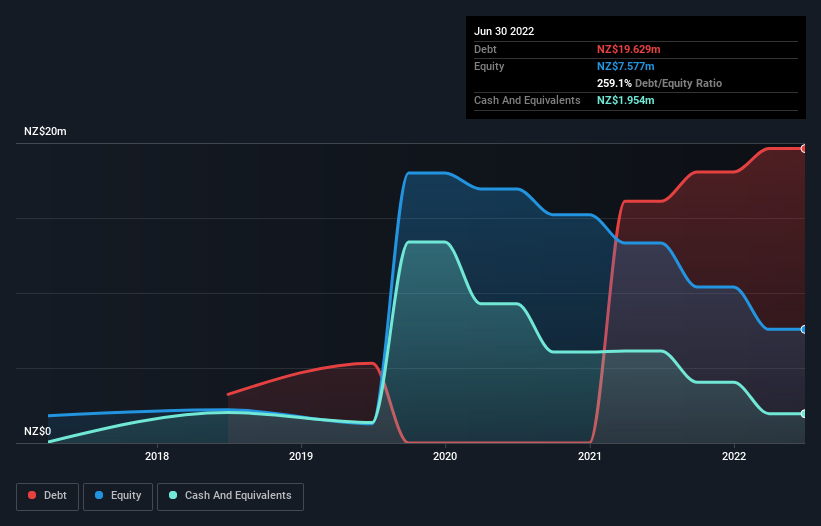
The external fund manager backed by Berkshire Hathaway's Charlie Munger, Li Lu, makes no bones about it when he says 'The biggest investment risk is not the volatility of prices, but whether you will suffer a permanent loss of capital.' When we think about how risky a company is, we always like to look at its use of debt, since debt overload can lead to ruin. Importantly, Happy Valley Nutrition Limited (ASX:HVM) does carry debt. But is this debt a concern to shareholders?
When Is Debt Dangerous?
Debt is a tool to help businesses grow, but if a business is incapable of paying off its lenders, then it exists at their mercy. In the worst case scenario, a company can go bankrupt if it cannot pay its creditors. While that is not too common, we often do see indebted companies permanently diluting shareholders because lenders force them to raise capital at a distressed price. Having said that, the most common situation is where a company manages its debt reasonably well - and to its own advantage. The first step when considering a company's debt levels is to consider its cash and debt together.
View our latest analysis for Happy Valley Nutrition
What Is Happy Valley Nutrition's Debt?
As you can see below, at the end of June 2022, Happy Valley Nutrition had NZ$19.6m of debt, up from NZ$16.1m a year ago. Click the image for more detail. On the flip side, it has NZ$1.95m in cash leading to net debt of about NZ$17.7m.

A Look At Happy Valley Nutrition's Liabilities
We can see from the most recent balance sheet that Happy Valley Nutrition had liabilities of NZ$9.91m falling due within a year, and liabilities of NZ$9.99m due beyond that. Offsetting these obligations, it had cash of NZ$1.95m as well as receivables valued at NZ$17.4k due within 12 months. So its liabilities total NZ$17.9m more than the combination of its cash and short-term receivables.
This deficit casts a shadow over the NZ$9.25m company, like a colossus towering over mere mortals. So we definitely think shareholders need to watch this one closely. After all, Happy Valley Nutrition would likely require a major re-capitalisation if it had to pay its creditors today. When analysing debt levels, the balance sheet is the obvious place to start. But it is Happy Valley Nutrition's earnings that will influence how the balance sheet holds up in the future. So when considering debt, it's definitely worth looking at the earnings trend. Click here for an interactive snapshot.
Given it has no significant operating revenue at the moment, shareholders will be hoping Happy Valley Nutrition can make progress and gain better traction for the business, before it runs low on cash.
Caveat Emptor
Importantly, Happy Valley Nutrition had an earnings before interest and tax (EBIT) loss over the last year. Its EBIT loss was a whopping NZ$2.8m. When we look at that alongside the significant liabilities, we're not particularly confident about the company. We'd want to see some strong near-term improvements before getting too interested in the stock. Not least because it burned through NZ$4.6m in negative free cash flow over the last year. So suffice it to say we consider the stock to be risky. There's no doubt that we learn most about debt from the balance sheet. But ultimately, every company can contain risks that exist outside of the balance sheet. For example, we've discovered 4 warning signs for Happy Valley Nutrition that you should be aware of before investing here.
If you're interested in investing in businesses that can grow profits without the burden of debt, then check out this free list of growing businesses that have net cash on the balance sheet.
Valuation is complex, but we're here to simplify it.
Discover if Happy Valley Nutrition might be undervalued or overvalued with our detailed analysis, featuring fair value estimates, potential risks, dividends, insider trades, and its financial condition.
Access Free AnalysisHave feedback on this article? Concerned about the content? Get in touch with us directly. Alternatively, email editorial-team (at) simplywallst.com.
This article by Simply Wall St is general in nature. We provide commentary based on historical data and analyst forecasts only using an unbiased methodology and our articles are not intended to be financial advice. It does not constitute a recommendation to buy or sell any stock, and does not take account of your objectives, or your financial situation. We aim to bring you long-term focused analysis driven by fundamental data. Note that our analysis may not factor in the latest price-sensitive company announcements or qualitative material. Simply Wall St has no position in any stocks mentioned.
About ASX:HVM
Happy Valley Nutrition
Happy Valley Nutrition Limited engages in the production and sale of infant milk formula and other nutritional products in New Zealand and internationally.
Medium and slightly overvalued.
Market Insights
Community Narratives




